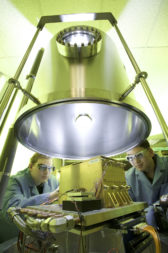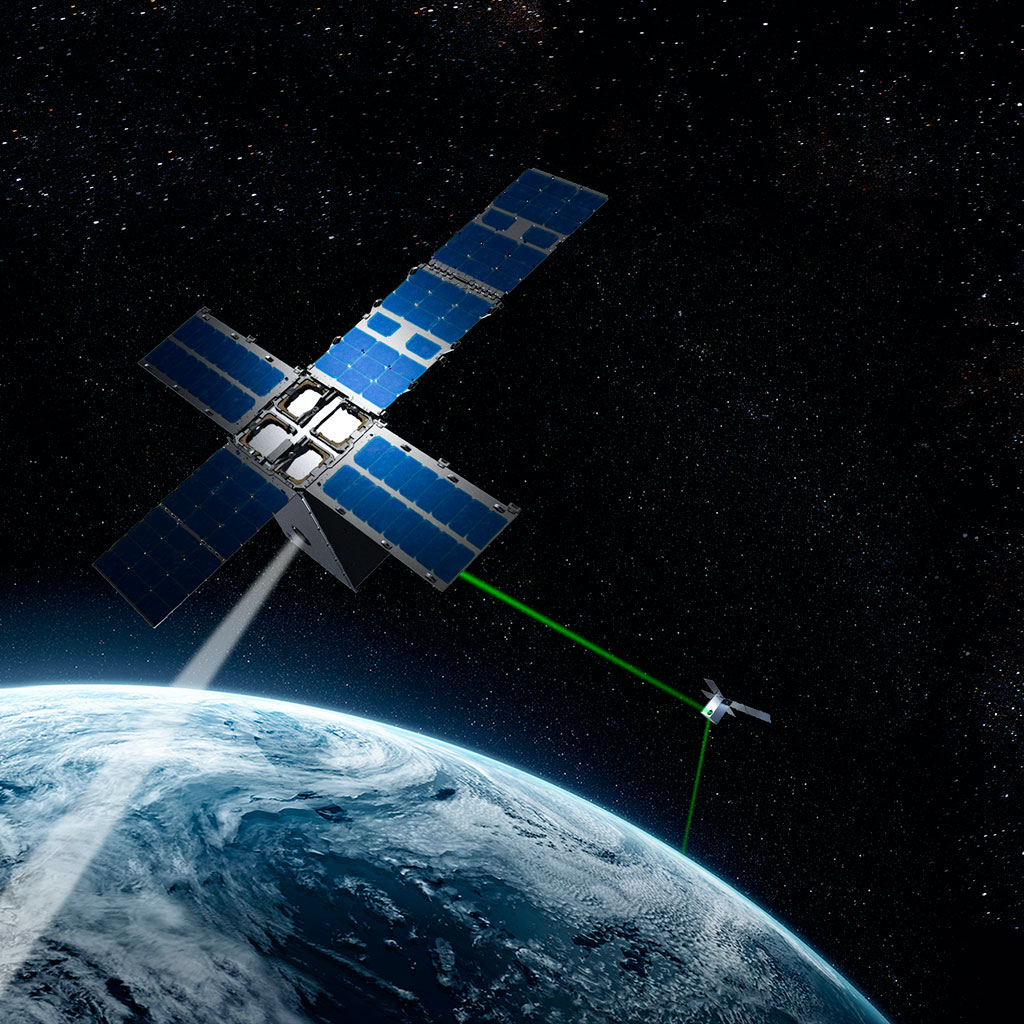The Space Development Agency says optical inter-satellite links are “one of the most critical technologies to be demonstrated.”
WASHINGTON — Optical communications terminals that use lasers to beam data across space will be tested in upcoming experiments by the Space Development Agency and the Defense Advanced Research Projects Agency.
These terminals are important pieces of DoD’s future low Earth orbit constellations which will require satellite-to-satellite optical crosslinks so data collected in space can be immediately sent to military command centers on the ground. Laser communications systems have much faster data transmission rates than radio-based systems but DoD has concerns such as the effects of space radiation on optical terminals and whether the electronics can withstand the stress of space launch.
“Optical inter-satellite links are one of the most critical technologies required to be demonstrated for Tranche 0,” the Space Development Agency said in a request for proposals issued last month for its communications constellation known at the transport layer. Tranche 0 is the initial deployment planned for 2022.
The satellites in the transport layer have to pass data in space and down to the ground to military users with very low latency. That can’t happen “without the demonstration and maturation of optical inter-satellite crosslinks — with radio frequency (RF) crosslinks as a backup,” the SDA request says. One of the concerns in using lasers for downlinks is penetrating the Earth’s atmosphere, especially through clouds.
SDA wants to build one or more constellations of hundreds of satellites for communications and for missile tracking. It plans to buy optical terminals from multiple vendors so it’s asking bidders to ensure their hardware is interoperable with those of other vendors.
Several companies make advanced optical terminals for NASA’s deep-space communications and follow common standards. But there is no accepted industry standard for optical inter-satellite links in lower orbits below geosynchronous range, according to SDA.
In its request for proposals, SDA included a recommended standard to make links interoperable but it will still need suppliers to collaborate to make sure their systems are compatible.
One of the companies now working with SDA on optical links is General Atomics Electromagnetic Systems. GA-EMS announced on June 5 that it signed an agreement with the agency to conduct a series of experiments for optical inter-satellite links using the company’s laser communication terminals.
“These experiments will demonstrate robust communication capabilities through multiple mediums, from Earth, to and between satellites in multiple orbits, and on in to deep space,” Scott Forney, president of GA-EMS, said in a statement.
For the experiment scheduled to launch in March 2021, the company will develop two 12U cubesats, each hosting an infrared payload and a laser communications terminal.
Another closely watched demonstration is DARPA’s Blackjack program. The agency next year plans to launch a pair of small satellites that will carry optical inter-satellite links made by SA Photonics. At the completion of the Blackjack program in 2022, DARPA’s goal is to demonstrate that an optically meshed network in LEO can provide global secure communications to the U.S. military.
Space Micro, a company that supplies space electronics to DoD and NASA, received an Air Force contract last year to develop a secure optical terminal for Air Force missions.
CEO David Strobel told SpaceNews that the SDA and DARPA programs will challenge the industry to make small low-power terminals that also can meet demanding performance targets.
DoD has a very different requirements than NASA’s deep-space programs that seek to establish communications with the moon and beyond. “NASA has proved the technology. But their terminals are not affordable for LEO programs.”
A key advantage of laser links is that they are extremely secure, said Strobel. “They’re virtually impossible to intercept.”

Before DARPA started the Blackjack program it awarded LGS Innovations in 2016 a contract to develop two small laser communication terminals to be used as inter-satellite links.
LGS Innovations, now owned by CACI International, delivered the terminals and DARPA plans to launch them in a future space experiment, Chris Simi, program manager at DARPA’s Strategic Technology Office, told SpaceNews.
Tom Wood, CACI’s senior director for optical communications and networking, said the company has been working on this technology for more than 20 years.
CACI is building a laser transmitter for NASA’s Deep Space Optical Communications project to bring back data from an asteroid to Earth.
Laser-based communications are “starting to get a lot of traction,” he told SpaceNews.
There are still some issues that need to be solved, he said. “We have to work through the risks with optical components such as how they perform in radiation.”
Wood said optical communications is attracting more interest because of the challenges and limitations of RF systems, said Wood. “The way engineers have addressed it in the last 15 years is by going to higher frequencies. But you’re still using electromagnetic waves to transmit information.”
The electromagnetic spectrum is in tight supply whereas the available spectrum is much greater in the optical band. “It’s about 8,000 gigahertz,” said Wood. “You can get essentially unlimited spectrum for transmissions. And you can get much higher throughput through optical systems than through radio systems,” he added. “This spectrum is unlicensed by the Federal Communications Commission or other authorities. You can build your equipment and go.”
